MALDI-induced Fragmentation of Leucine enkephalin, Nitro-Tyr Leucine Enkaphalin, and d(5)-Phe-Nitro-Tyr Leucine Enkephalin
- PMID: 20161518
- PMCID: PMC2799299
- DOI: 10.1016/j.ijms.2008.08.020
MALDI-induced Fragmentation of Leucine enkephalin, Nitro-Tyr Leucine Enkaphalin, and d(5)-Phe-Nitro-Tyr Leucine Enkephalin
Abstract
The long-term objective of this study is to use MALDI MS and MS/MS to study the fragmentation pattern of in vitro nitrotyrosine-containing peptides in order to assist the interpretation of MS-identification of endogenous nitroproteins in human tissues and fluids. The short-term objective is to study synthetic leucine enkephalin, nitro-Tyr-leucine enkephalin, and d(5)-Phe-nitro-Tyr-leucine enkephalin with a vacuum matrix-assisted laser desorption/ionization linear ion-trap mass spectrometer (vMALDI-LTQ). The results demonstrated the UV laser-induced photochemical decomposition of the nitro group. Although photochemical decomposition decreased the ion intensity and complicated the MS spectrum, the recognition of that unique decomposition pattern unambiguously identified a nitrotyrosine. The a(4)- and b(4)-ions were the most-intense fragment ions found in the MS/MS spectra for those three synthetic peptides. Compared to the unmodified peptides, more collision energy optimized the fragmentation of the nitropeptide, increased the intensity of the a(4)-ion, and decreased the intensity of the b(4)-ion. Optimized laser fluence maximized the fragmentation of the nitropeptide. MS(3) analysis confirmed the MS(2)-derived amino acid sequence, but required much more sample. To detect a nitropeptide, the sensitivity of vMALDI-LTQ is 1 fmol for MS detection and 10 fmol for MS(2) detection; the S/N ratio was ca. 50:1 in those studies. Those data are important for an analysis of low-abundance endogenous nitroproteins, where preferential enrichment of nitroproteins and optimized mass spectrometry parameters are used.
Figures
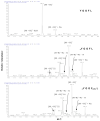
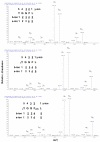
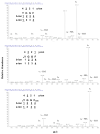




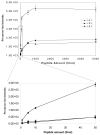

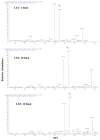
Similar articles
-
Comparison of CID spectra of singly charged polypeptide antibiotic precursor ions obtained by positive-ion vacuum MALDI IT/RTOF and TOF/RTOF, AP-MALDI-IT and ESI-IT mass spectrometry.J Mass Spectrom. 2006 Apr;41(4):421-47. doi: 10.1002/jms.1032. J Mass Spectrom. 2006. PMID: 16604520
-
Analysis of peptides and proteins containing nitrotyrosine by matrix-assisted laser desorption/ionization mass spectrometry.J Am Soc Mass Spectrom. 2001 Apr;12(4):439-48. doi: 10.1016/S1044-0305(01)00213-6. J Am Soc Mass Spectrom. 2001. PMID: 11322190
-
Structural characterisation of tyrosine-nitrated peptides by ultraviolet and infrared matrix-assisted laser desorption/ionisation Fourier transform ion cyclotron resonance mass spectrometry.Eur J Mass Spectrom (Chichester). 2005;11(5):513-8. doi: 10.1255/ejms.777. Eur J Mass Spectrom (Chichester). 2005. PMID: 16322657
-
Leucine enkephalin--a mass spectrometry standard.Mass Spectrom Rev. 2011 Mar-Apr;30(2):298-320. doi: 10.1002/mas.20279. Epub 2010 Jul 28. Mass Spectrom Rev. 2011. PMID: 20669325 Review.
-
Mass spectrometry analysis of nitrotyrosine-containing proteins.Mass Spectrom Rev. 2015 Jul-Aug;34(4):423-48. doi: 10.1002/mas.21413. Epub 2013 Dec 6. Mass Spectrom Rev. 2015. PMID: 24318073 Review.
Cited by
-
Nitroproteomics is instrumental for stratification and targeted treatments of astrocytoma patients: expert recommendations for advanced 3PM approach with improved individual outcomes.EPMA J. 2023 Dec 6;14(4):673-696. doi: 10.1007/s13167-023-00348-y. eCollection 2023 Dec. EPMA J. 2023. PMID: 38094577 Free PMC article. Review.
-
Supraspinal peroxynitrite modulates pain signaling by suppressing the endogenous opioid pathway.J Neurosci. 2012 Aug 8;32(32):10797-808. doi: 10.1523/JNEUROSCI.6345-11.2012. J Neurosci. 2012. PMID: 22875915 Free PMC article.
-
Cell-Instructive Surface Gradients of Photoresponsive Amyloid-like Fibrils.ACS Biomater Sci Eng. 2021 Oct 11;7(10):4798-4808. doi: 10.1021/acsbiomaterials.1c00889. Epub 2021 Sep 13. ACS Biomater Sci Eng. 2021. PMID: 34515483 Free PMC article.
-
Nitroproteins in Human Astrocytomas Discovered by Gel Electrophoresis and Tandem Mass Spectrometry.J Am Soc Mass Spectrom. 2015 Dec;26(12):2062-76. doi: 10.1007/s13361-015-1270-3. Epub 2015 Oct 8. J Am Soc Mass Spectrom. 2015. PMID: 26450359
-
Pituitary adenoma nitroproteomics: current status and perspectives.Oxid Med Cell Longev. 2013;2013:580710. doi: 10.1155/2013/580710. Epub 2013 Mar 7. Oxid Med Cell Longev. 2013. PMID: 23533694 Free PMC article. Review.
References
-
- Dalle-Donne I, Scaloni A, Giustarini D, Cavarra E, Tell G, Lungarella G, Colombo R, Rossi R, Milzani A. Mass Spectrom. Rev. 2005;24:55. - PubMed
-
- Dalle-Donne I, Scaloni A, Butterfield DA, editors. Redox Proteomics: From Protein Modifications to Cellular Dysfunction and Diseases. John Wiley & Sons, Inc.; Hobokein, New Jersey: 2006. - PubMed
-
- Zhan X, Desiderio DM. Biochem. Biophys. Res. Commun. 2004;325:1180. - PubMed
-
- Zhan X, Desiderio DM. International J. Mass Spectrom. 2007;259:96.
-
- Zhan X, Desiderio DM. Anal. Biochem. 2006;354:279. - PubMed
Grants and funding
LinkOut - more resources
Full Text Sources
